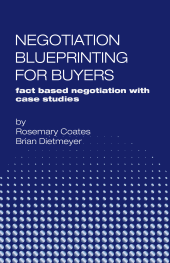introduction by rosemary coates
I was first introduced to Think! Inc. in 2008. A colleague set up an initial phone call with Brian Dietmeyer, the CEO of Think! Inc., to explore the possibilities of joining the team. At the time, Think! Inc. was primarily focused on training salespeople. But I had always worked and consulted on the buying and operations side of business, so I was interested in what the company could do for buyers. In preparation for the call with Brian, I ordered Strategic Negotiation from Amazon.com and spent a weekend reading and thinking about the Think! Inc. methodology.
As I read through the chapters, I became completely intrigued. I had never seen anything like this before. The methodology was simple and elegant and it made perfect sense. I knew buyers were going to love it. I couldn’t wait to talk with Brian about building a procurement practice. So it began.
Since that time, we have trained many buyers in the Think! Inc. methodology, with outstanding results. Our clients report negotiating deals with much greater value for their companies and vastly improved supplier relations and cost savings. Most importantly, buyers who have been successfully doing their jobs well for many years tell us that Think! Inc. opened their eyes to creativity and results they never imagined were possible and, as an added bonus, made their jobs a whole lot more fun.
The negotiating method and tools we teach are simple and more of a toolset instead of the check-off lists taught by other companies and consultants. This approach is so much more appropriate for today’s buying environment where buyers are more sophisticated, better educated and more thoughtful in terms of the needs of their business.
Since the 1980s, industrial buying has gone from getting three quotes and executing a three-part carbon paper Purchase Order typed on an IBM Selectric typewriter, to a sophisticated electronic environment where information is available at the buyer’s computer command. With the introduction of ERP systems buyers can now assemble historical buy information, supplier history and performance, develop RFPs, RFQs and enable reverse auctions. Electronically, buyers can exchange offers with suppliers and transmit Purchase Orders via EDI. Procurement is now taught at the undergraduate and the graduate levels as part of Supply Chain Management programs at universities around the world. Students emerging from graduate programs are more strategic thinkers and have a much broader understanding of businesses as ecosystems.
Sellers are also getting more sophisticated. By doing online research, they have a much better understanding of their competition and of their company. They can quote from your annual report and cite your CEO’s direction for the near future. Through email they may be talking to many other people in the company, selling to the business and bypassing Purchasing like never before. They too, are better educated and sell value-based solutions. Gone are the days of taking buyers to lunch and expecting a purchase order in return.
And finally, deals have changed. Today, deals are rarely about just one price for one product. Buyers now find themselves buying products and services that include software, maintenance agreements, training, field service, supplier-managed inventory and a host of other things. Requirements are based on tight forecasts, Sales and Operations Planning (S&OP), and Lean principles. Buys are likely to be international, whether the buyer is purchasing from a local distributor or buying directly from overseas. International buying is complicated by currency, culture, communications and global time zones. All of this means more complexity in every buy as well as many new opportunities for far better negotiations.
Oh, how the buying world has changed!
1. Brian J. Dietmeyer with Rob Kaplan, Strategic Negotiation: A Breakthrough Process for Blueprinting Business Negotiation (Chicago: Kaplan Publishing, 2004).
to purchase book
Click here.


